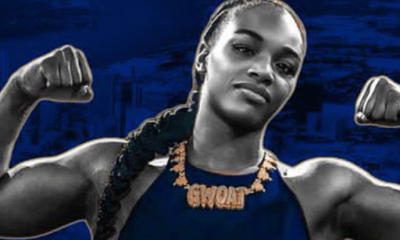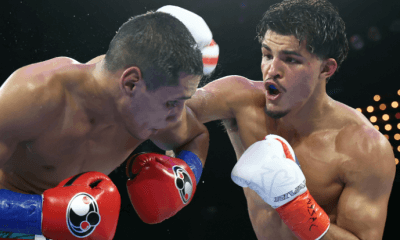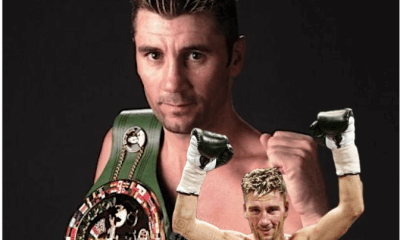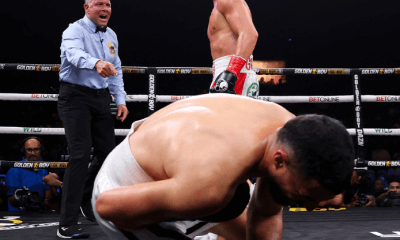Featured Articles
Talking Boxing with Renowned New York Sports Journalist Wally Matthews

If one had the ability to construct a prototypical New York City boxing writer, it would be in the mold of Wally Matthews.
This observation was put forward by Mark Kriegel, a New York City native and one of the preeminent journalists and authors of this generation.
“Coming from Kriegel, one of the finest newspaper columnists I’ve ever read, that is high praise indeed,” Matthews admitted. “I think what he means is, I was the type who wasn’t afraid to ask a hard question or take an unpopular stance, and I didn’t take any crap from anyone (still don’t) … I plead guilty on all counts.”
Aside from being a standout boxing scribe, Matthews also covered baseball and many other sports, but it was the manly art that seemed to suit him best.
“I was lucky enough to cover boxing when it was important enough for every paper to have a full-time boxing writer in an era when for a couple of nights a year, the whole world would stop to watch a major fight. Considering I covered [Marvin] Hagler-[Thomas] Hearns, Hagler-[Ray] Leonard], [Larry] Holmes-[Michael] Spinks I and II, just about every Mike Tyson fight as well as [Roberto] Duran, [Oscar] De La Hoya, [Felix] Trinidad, [James] Toney and Roy Jones Jr. as both Olympian and professional, I think the case can be made that I was fortunate enough to land smack in the middle of one of boxing’s golden ages,” said Matthews, who left three credits shy of a bachelor’s degree in Journalism from C.W. Post University after taking a full-time job with Long Island Newsday, where he worked from 1983 to 1994. “My fight stories often landed on the back page of Newsday and the [New York] Post [1994 to 2002]. That doesn’t happen anymore, no matter who’s fighting. Clearly, the period from 1985 through 2000 was a special era for boxing.”
Even though Matthews, who returned to Newsday [2005 to 2010] is no longer seated ringside, he thinks the fight game is pretty much the same.
“The fights themselves haven’t changed. It’s still two individuals stripped of virtually everything but their courage and determination and taking part in the most demanding test of a human being short of actual armed combat,” he said. “And yes, I include MMA in that assessment, because any combat sport in which a participant can quit (or “tap out”) when the going gets tough, with no loss of honor is not really a combat sport. So those things about boxing remain the same and always will.”
There have been slight changes in boxing, and not always for the betterment.
“Where it has changed is in the public perception of it, much of which is the fault of the boxing establishment itself, with the establishment of multiple titleholders, interim champions, and all the other bull****, and much of it the fault of the promoters, who are very short-sighted and only seem interested in how much they can make today,” said Matthews, who is currently collaborating on a book with Bob Gutkowski, former president of Madison Square Garden. “As a result, boxing’s audience has dwindled to the hardcore couple of hundred thousand who are willing to shell out $75 or $100 (I’m not even sure since I refuse to pay for a fight) for an attractive matchup while the rest of the public shrugs its shoulders and moves on. The days of building up a fighter through frequent television exposure are long gone, meaning only true boxing nerds know or care about who the real champions and contenders are.”
Some of boxing’s problems reside at the feet of the men and women covering the sport.
“Also, the way boxing is covered has changed drastically and not for the better. It seems the boxing media is now populated by fanboys of certain fighters or those who seem, by the tone of their coverage, to be in the pocket of certain promoters,” said Matthews, who added ESPN Radio [2002-2005], ESPN [2010-2016], the New York Times [2016-2018], the New York Daily News [2018-2019] and Yahoo Sports [2019-2020] to his resume. “There’s no room anymore for an impartial observer who is willing to criticize based on merit. They get shouted down at press conferences and refused credentials. (I know this from experience because it used to happen to me when I was at odds with the Tyson camp). Now, the practice is much more widespread than when I covered boxing and is one of the reasons I stopped going to fights or pitching freelance boxing stories. It is true to an extent in all sports these days that adversary journalism has given way to access journalism, but more so it appears in boxing.”
There was a period when the most top-flight sportswriters were assigned the boxing beat and they usually brought back gems.
“It used to be said that newspapers would put their best writers on boxing because there was so much to be mined from each fight and each fighter, and a hack couldn’t do it,” said Matthews, who received his certification as a fitness trainer last September and is presently running the boxing program at the Huntington, New York YMCA, and is also hosting a film series on journalism in the movies at a local independent cinema. “Unfortunately, editors no longer feel that way and now assign the people on their lowest rungs to the fight game, a reflection on how far the sport’s image and popularity have fallen.”
Boxing’s attraction is that it’s man at his most basic.
“For me, the most compelling aspect of boxing was that it was a one-on-one confrontation between two men (women’s boxing was in its infancy at the time) with everything at stake, every time out, including their lives,” Matthews pointed out. “By comparison, and I’ve written this many times, there is NOTHING at stake in a baseball, football, hockey or basketball game. Everyone gets paid, everyone has a contract, everyone goes home more or less in one piece and everyone gets to play another day. Not so in boxing. I did find that when I covered baseball, the series of one-on-one confrontations between batter and pitcher somewhat resembled a boxing match, but beyond that, there is little to no urgency in any single game unless it’s Game 7 of the World Series.”
Matthews continued his thought: “I’ve always said there is more drama in the moments just preceding the opening bell of a heavyweight title fight than in all the Super Bowls, World Series, NBA Championships and Stanley Cup Finals put together, and I’ve covered all of them,” he offered. “Only horse racing, another sport which can only be “played” by adults, even comes close.”
While boxing is physically and mentally challenging, the practitioners are usually willing talkers.
“In my era, I found the athletes easier to deal with because most of them came from humble backgrounds and of course, there is something very humbling about being beaten in a boxing match,” posited Matthews. “So yeah, I found just about every fighter I’ve ever covered to have a deep well of humanity and humility not often found in other sports. I have no idea if it’s still like that but since the essential nature of boxing hasn’t changed, I imagine most of the fighters haven’t, either.”
Having covered boxing for decades, there were a few pugilists who stood out when it came to speaking with the media.
“Tyson, of course, was always great copy, even at his surliest and most threatening,” Matthews noted. “Or maybe especially at his surliest and most threatening. I found [George] Foreman to be fascinating when you could get him out of his Fighting Preacher shtick. I always loved talking boxing with Gil Clancy, Ray Arcel, Emanuel Steward and Angelo Dundee. They were treasure troves of stories and information. And wonderful gentlemen to boot.”
Along with these titans, Matthews mentioned one boxer who was otherworldly gifted.
“The best all-around fighter has got to be Sugar Ray Leonard. A generational talent who was a unique blend of speed, grace, natural skill and killer instinct,” he said. “Some people were fooled by that schoolboy grin of his, but Ray was a great puncher and a stone-cold killer. Terrific left hook.”
There were a few others who stood apart from the crowd.
“Foreman was the best puncher I ever saw. [Evander] Holyfield had more self-belief than anyone I had ever known, or will ever know,” Matthews said. “And Iran Barkley might be the most courageous individual I ever covered. A gallant fighter who gave boxing more than he ever got in return. He deserved much better.”
Having a ringside seat at many of the best and most important bouts, Matthews rolled off some of his favorite matches.
“Hagler-Hearns. No explanation needed. Tyson-Holyfield I, because the dominance of Holyfield was so unexpected,” he said. “Foreman-[Michael] Moorer, which along with the Rangers winning the Stanley Cup in 1994, was the most incredible event I’ve ever witnessed because of the drama involved. Also loved Hagler-Leonard.”
When questioned what single sporting event Matthews would choose to attend, he selected something that took place nearly a century ago.
“Put me in [Chicago’s] Soldier Field for the seventh round of the [Jack] Dempsey-[Gene] Tunney rematch and I’m in heaven,” he said of that 1927 matchup. “I want to see for myself if Tunney could have gotten up.”
Now that’s sweet.
To comment on this story in the Fight Forum CLICK HERE
-

 Featured Articles3 weeks ago
Featured Articles3 weeks agoResults and Recaps from New York Where Taylor Edged Serrano Once Again
-

 Featured Articles3 days ago
Featured Articles3 days agoThe Hauser Report: Zayas-Garcia, Pacquiao, Usyk, and the NYSAC
-

 Featured Articles3 weeks ago
Featured Articles3 weeks agoResults and Recaps from NYC where Hamzah Sheeraz was Spectacular
-

 Featured Articles3 weeks ago
Featured Articles3 weeks agoFrom a Sympathetic Figure to a Pariah: The Travails of Julio Cesar Chavez Jr
-

 Featured Articles3 weeks ago
Featured Articles3 weeks agoPhiladelphia Welterweight Gil Turner, a Phenom, Now Rests in an Unmarked Grave
-

 Featured Articles2 weeks ago
Featured Articles2 weeks agoManny Pacquiao and Mario Barrios Fight to a Draw; Fundora stops Tim Tszyu
-

 Featured Articles1 week ago
Featured Articles1 week agoArne’s Almanac: Pacquiao-Barrios Redux
-

 Featured Articles4 weeks ago
Featured Articles4 weeks agoCatterall vs Eubank Ends Prematurely; Catterall Wins a Technical Decision



















